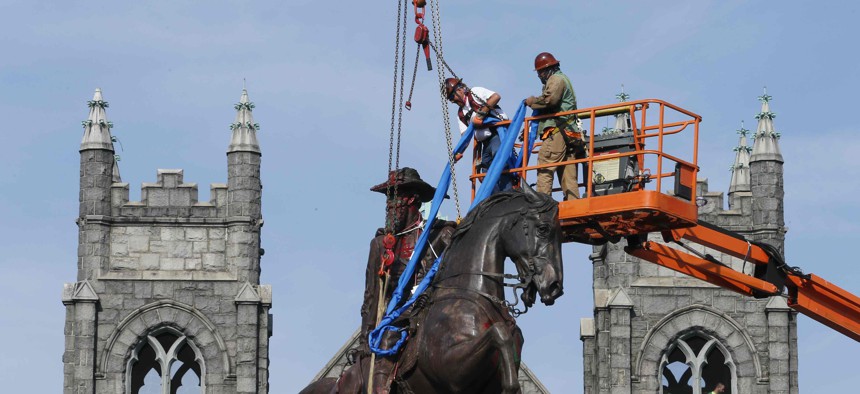The States Where The Most Confederate Symbols Were Removed Last Year

Crews attach straps to the statue Confederate General J.E.B. Stuart on Monument Avenue in Richmond, Va. AP Photo/Steve Helber
The Southern Poverty Law Center says nationwide over 160 monuments and other symbols came down from public spaces.
Communities across the U.S. saw at least 168 Confederate monuments, statues and other symbols removed from public spaces last year—71 of them in Virginia, the state with the most removals, according to a report from the Southern Poverty Law Center.
The group says more than 2,100 Confederate symbols are still publicly present in the U.S. and that 704 of them are monuments. The total figure includes government buildings, schools, streets and other public property named after people associated with the Confederacy.
Lecia Brooks, SPLC’s chief of staff, described 2020 as a “transformative year” for the movement to remove Confederate symbols from public spaces and said more were removed in seven months last year than in the preceding four years combined.
Opponents of statues and other tributes to Confederate figures argue that they serve as representations of racism and white supremacy. “These dehumanizing symbols of pain and oppression continue to serve as backdrops to important government buildings, halls of justice, public parks, and U.S. military properties,” Brooks said.
SPLC began to document Confederate symbols in public spaces after a white supremacist gunman in 2015 killed nine Black people attending a Bible study at a church in Charleston, South Carolina.
Other states that removed the most symbols last year, according to the report, included: North Carolina, with 24 removals and Alabama and Texas, which each eliminated a dozen.
Of the symbols removed last year, 94 were monuments. That’s compared to 58 Confederate monuments removed from 2015 to 2019.
The symbols are typically located in the South, often in states with preservation laws that can block communities from making local decisions about what should be done with them.
Some groups, like Sons of Confederate Veterans, have defended keeping memorials for those who fought for the South in the Civil War, saying that their removal erases history and eliminates tributes that are important to descendants of those who died in the war.
A list of the 168 Confederate symbols removed last year can be found here.
Brent Woodie is an associate editor for Route Fifty.
NEXT STORY: Rural Americans in Pharmacy Deserts Hurting for Covid Vaccines





